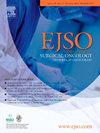Machine learning prediction of perineural invasion in intrahepatic cholangiocarcinoma
IF 2.9
2区 医学
Q2 ONCOLOGY
引用次数: 0
Abstract
Objective
Perineural invasion (PNI) significantly influences postoperative recurrence and survival in intrahepatic cholangiocarcinoma (ICC) patients. This study aims to develop and validate an interpretable model that can be used to predict PNI in ICC cases before surgery.
Methods
Retrospective clinical information was gathered from ICC patients (n = 250) at our hospital, covering the period from January 2012 to January 2022. The patients were randomly assigned to the training group (n = 176, 70.4 %) and validation group (n = 74, 29.6 %). We employed four machine learning algorithms to establish prediction models, each model's performance was assessed via a receiver operating characteristic (ROC) curve. Decision Curve Analysis (DCA) was performed to evaluate the models' risks and benefits. SHapley Additive exPlanations (SHAP) were used to quantify the contributions of model features, providing both global and local interpretations.
Results
Significant differences in tumor size, tumor number, lymph node metastasis, CA199, distant metastasis ratio, HBsAg, PLR, and NLR were observed between the PNI[-] (n = 172, 68.8 %) and PNI[+](n = 78, 31.2 %) groups. The PFS and OS rates in the PNI[-] group were better than those in the PNI[+] group. Based on the evaluation of the validation group, the XGBoost model demonstrated the best predictive performance. SHAP analysis identified tumor number, tumor size, and lymph node metastasis as the top three factors predicting PNI in ICC patients.
Conclusion
We developed a reliable predictive model that effectively predicts PNI status in patients with ICC and facilitates personalized clinical decision-making.
机器学习预测肝内胆管癌神经周围浸润
目的围神经侵犯(PNI)对肝内胆管癌(ICC)患者术后复发和生存有显著影响。本研究旨在开发和验证一个可解释的模型,用于在手术前预测ICC病例的PNI。方法回顾性收集我院2012年1月至2022年1月期间ICC患者(n = 250)的临床资料。将患者随机分为训练组(n = 176, 70.4%)和验证组(n = 74, 29.6%)。我们采用四种机器学习算法建立预测模型,每个模型的性能通过受试者工作特征(ROC)曲线进行评估。采用决策曲线分析(DCA)对模型的风险和效益进行评价。SHapley加性解释(SHAP)用于量化模型特征的贡献,提供全局和局部解释。结果PNI[-]组(n = 172, 68.8%)与PNI[+]组(n = 78, 31.2%)在肿瘤大小、肿瘤数目、淋巴结转移、CA199、远处转移率、HBsAg、PLR、NLR等指标上差异均有统计学意义。PNI[-]组的PFS和OS率均优于PNI[+]组。根据验证组的评估,XGBoost模型的预测性能最好。SHAP分析发现,肿瘤数量、肿瘤大小和淋巴结转移是预测ICC患者PNI的前三大因素。结论我们建立了一个可靠的预测模型,可以有效地预测ICC患者的PNI状态,促进个性化的临床决策。
本文章由计算机程序翻译,如有差异,请以英文原文为准。
求助全文
约1分钟内获得全文
求助全文
来源期刊

Ejso
医学-外科
CiteScore
6.40
自引率
2.60%
发文量
1148
审稿时长
41 days
期刊介绍:
JSO - European Journal of Surgical Oncology ("the Journal of Cancer Surgery") is the Official Journal of the European Society of Surgical Oncology and BASO ~ the Association for Cancer Surgery.
The EJSO aims to advance surgical oncology research and practice through the publication of original research articles, review articles, editorials, debates and correspondence.
 求助内容:
求助内容: 应助结果提醒方式:
应助结果提醒方式:


